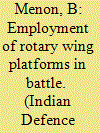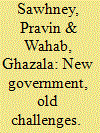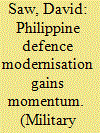| Srl | Item |
| 1 |
ID:
132280


|
|
|
|
|
| Publication |
2014.
|
| Summary/Abstract |
The use of conventional armed forces in a deterrent role merits close consideration. Instability in weak or failing states can have global ramifications, while efforts to build stability take time. In principle, conventional deterrence can be used to buy the time required for such stabilization efforts. Attempts at deterrence will, however, need to overcome credibility problems stemming from the technical limitations associated with conventional armed forces, and with the likely requirement for multiple external actors to deter multiple intrastate audiences. While deterrence might work under certain circumstances, it will not play as central a role in strategy as it did during the Cold War.
|
|
|
|
|
|
|
|
|
|
|
|
|
|
|
|
| 2 |
ID:
133046


|
|
|
|
|
| Publication |
2014.
|
| Summary/Abstract |
Apart from other roles, insurgencies in Malaya, Kenya, Zimbabwe, French lndo-China and Algeria saw helicopters being used for troop induction into and extraction from combat zones, rudimentary fire support to ground forces and surveillance. Most operations were confined to daytime and in relatively clear weather due to equipment limitations. In almost all scenarios, there was a marked asymmetry in terms at technology and equipment in favour of conventional forces. Some success in these operations led to the assumption that with the added advantages oi hover capability helicopters were relatively invulnerable when compared to fixed wing aircraft.
|
|
|
|
|
|
|
|
|
|
|
|
|
|
|
|
| 3 |
ID:
129937


|
|
|
| 4 |
ID:
132988


|
|
|
|
|
| Publication |
2014.
|
| Summary/Abstract |
The Philippines has embarked on an ambitious and yet necessary programme of defence modernization as it seeks to enable the Armed Forces of the Philippines (AFP) to recover from years of neglect since the pull-out of US Forces. The current defence modernization programme is not the first time that a Philippine government has tried to confront the task of military modernization. however, now modernization is imperative as Philippines sovereignty is challenged from conventional and asymmetrical forces.
|
|
|
|
|
|
|
|
|
|
|
|
|
|
|
|
| 5 |
ID:
177811


|
|
|
|
|
| Summary/Abstract |
Contemporary debates on Russian nuclear strategy focus on making sense of Russia’s nuclear capabilities, signalling and nuclear declarations. This paper argues that understanding how nuclear capabilities and strategy interact with conventional capabilities is fundamental to understanding nuclear strategy. It offers the Conventional Balance of Forces thesis for explaining change in Russia’s nuclear strategy after the Cold War. It shows how Russian nuclear debates and strategy decisions have been affected by perceived conventional vulnerabilities, and how the orthodox Western interpretation of Russian nuclear strategy today as one of ‘escalating to de-escalate’ comes short of explaining when Russia would go nuclear in conflict, and why.
|
|
|
|
|
|
|
|
|
|
|
|
|
|
|
|